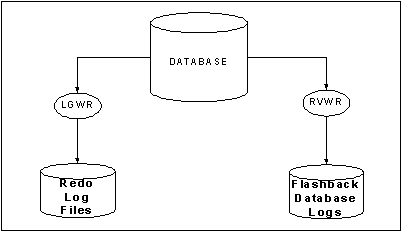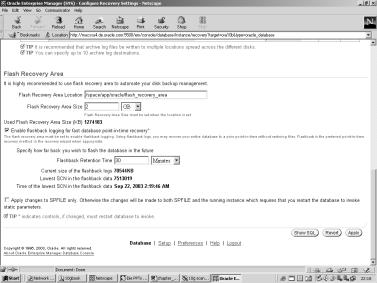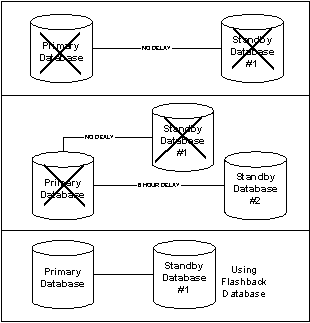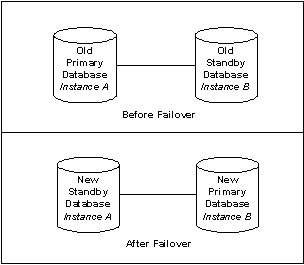Oracle 10g New Features: Flashback and RMAN
Two improvements have been made in the backup and recovery areas in Oracle 10g. When user errors and logical corruptions occur in the database, flashback functionalities provide fast and flexible data recovery. When physical or media corruption occurs in the database, RMAN delivers an improved and simplified recovery method.
Here is a list of extended flashback features:
Flashback Database - This feature introduces the FLASHBACK DATABASE statement in SQL. It allows you to quickly bring your database to a prior point in time by undoing all of the changes that have taken place since that time. This operation is fast, because you do not need to restore the backups. This results in much less downtime following data corruption or human error.
Flashback Standby Database - This feature improves the switchover and failover time of a standby database. You no longer need to specify a log apply delay, because you can now roll back the standby database if an error occurs on the primary and is propagated to the standby.
Flashback Reinstantiation - This feature reduces the need to reinstantiate the old primary database following a failover. This in turn lets you restore full resiliency after a failure more quickly. You can do this by using the SQL statement FLASHBACK DATABASE to roll back the primary database in time to synchronize with the standby database.
Flashback Drop - Oracle now provides a way to restore tables that were dropped accidentally.
Flashback Table - This feature introduces the FLASHBACK TABLE statement in SQL, which lets you quickly recover a table to a previous point in time without restoring a backup.
Flashback Row History - Using undo data stored in the database, you can now view the changes to one or more rows along with all the metadata of the changes.
Flashback Transaction History - This feature lets you examine changes to the database at the transaction level. With flashback transaction history, you can diagnose problems, perform analysis, and audit transactions.
Here is a list of enhanced RMAN features:
Automated Channel Failover for Backup and Restore - Recovery Manager (RMAN) now automatically retries a failed backup or restore operation, reducing the risk of stranding you without a backup of the Oracle database because of an error.
Automated File Creation During Recovery - This feature enhances RMAN recovery by automatically creating and recovering datafiles that have never been backed up.
Simplified Backups to Disk - Image backups provide fast recovery by being readily usable. The Recovery Manager (RMAN) BACKUP command has been enhanced to perform image copy backups at the database, tablespace, and datafile level.
Proxy Copy Backup of Archivelogs - You can now back up archive logs by using the Recovery Manager (RMAN) Proxy Copy.
Incrementally Updated Backups - You can now apply a Recovery Manager (RMAN) incremental backup to a datafile image backup. This results in reduced recovery time, because fewer logs need to be applied, and reduced time to back up the database, because you do not always have to back up the whole database.
Simplified Recovery Through Resetlogs - You no longer have to backup your database following an incomplete recovery or an OPEN RESETLOGS operation. This is an enabling feature for Flashback Reinstantiation.
Full Database Begin Backup Command - It is no longer necessary to issue a separate command to place each tablespace in hot backup mode. You can now use the ALTER DATABASE statement to place all tablespaces in backup mode. Also, the BEGIN BACKUP command now runs faster than before.
Changes to the ALTER DATABASE END BACKUP Command - You can issue the ALTER DATABASE END BACKUP command when the database is open.
Change-Aware Incremental Backups - By using a new type of log file to track blocks that have changed in the database, Recovery Manager (RMAN) can avoid scanning the entire datafile during an incremental backup. Instead, the amount of data scanned is proportional to the amount of data changed.
Automated Disk-Based Backup and Recovery - This release supports automated disk-based backup and recovery. The result is a simplified and unified storage location for backups, archivelogs, and any other files needed for Oracle recovery. It also provides automatic deletion of the files after they have been successfully backed up by RMAN, and the equivalent of a disk cache for tape, which reduces the time needed to restore a file from tape. It reduces the risk of an out-of-space condition on disk by deleting files that are no longer necessary for successful database recovery.
RMAN Database Dropping and Deregistration - The new DROP DATABASE and UNREGISTER DATABASE RMAN commands remove the database and its entry from the RMAN recovery catalog.
Automated TSPITR Instantiation - This feature automatically creates the auxiliary instance needed to perform tablespace point-in-time recovery (TSPITR) and incorporates the RMAN TSPITR operations.
Simplified Recovery Manager Cataloging of Backup Files - You can now catalog RMAN proprietary backup metadata into a backup repository. If a backup is overwritten in the control file, or a backup file is moved to a new location on disk, then you can easily uncatalog the backup metadata from the repository.
Extended Flashback Functions
In Oracle 10g, the flashback functionality has been greatly extended.
Flashback Database
Flashback Database is faster than traditional point-in-time recovery. Traditional recovery uses redo log files and backups. Flashback Database is implemented using a new type of log file called Flashback Database logs. The Oracle database server periodically logs before images of data blocks in the Flashback Database logs. The data block images are used to quickly back out changes to the database during Flashback Database.
Flashback Database reduces the time required to recover the database to a previous point. The time to restore a database is proportional to the number of changes that need to be backed out, not the size of the database.
RVWR Background Process
When Flashback Database is enabled, a new RVWR background process is started. This process is similar to the LGWR (log writer) process. The new process writes Flashback Database data to the Flashback Database logs.
 Figure 12.1 RVWR Background process and Flashback Database Logs
Figure 12.1 RVWR Background process and Flashback Database Logs
The list below shows all the background processes for the 'grid' instance.
$ ps -ef | grep grid
oracle 25124 1 0 16:32:05 ? 0:00 ora_s000_grid
oracle 25116 1 0 16:32:04 ? 0:00 ora_reco_grid
oracle 25169 1 0 16:32:22 ? 0:00 ora_rvwr_grid
oracle 25112 1 0 16:32:04 ? 0:00 ora_ckpt_grid
oracle 25110 1 0 16:32:04 ? 0:00 ora_lgwr_grid
oracle 25108 1 0 16:32:04 ? 0:00 ora_dbw0_grid
oracle 25114 1 0 16:32:04 ? 0:00 ora_smon_grid
oracle 25118 1 0 16:32:04 ? 0:00 ora_cjq0_grid
oracle 25120 1 0 16:32:04 ? 0:00 ora_rbal_grid
oracle 25122 1 0 16:32:04 ? 0:00 ora_d000_grid
oracle 25106 1 0 16:32:04 ? 0:00 ora_pmon_grid
Enabling Flashback Database
You can enable Flashback Database using the following steps:
- Make sure the database is in archive mode.
- Configure the recovery area by setting the two parameters:
- db_recovery_file_dest
- db_recovery_file_dest_size - Open the database in MOUNT EXCLUSIVE mode and turn on the flashback feature:
SQL> STARTUP MOUNT EXCLUSIVE; SQL> ALTER DATABASE FLASHBACK ON;
- Set the Flashback Database retention target:
- db_flashback_retention_target - Determine if Flashback Database is enabled:
SQL> select flashback_on 2 from v$database; FLASHBACK_ON ------------ YES
Disabling Flashback Database
Issue the following command to disable Flashback Database:
SQL> ALTER DATABASE FLASHBACK OFF;
You can also perform the same task in Enterprise Manger:
 Figure 12.2 Disabling Flashback Database in Enterprise Manager
Figure 12.2 Disabling Flashback Database in Enterprise Manager
Monitoring Flashback Database
The following displays a selection of the Flashback Database logs:
SQL> select begin_time, flashback_data, 2 db_data, redo_data, ESTIMATED_FLASHBACK_SIZE 3 from v$flashback_database_stat;BEGIN_TIME FLASHBACK_DATA DB_DATA REDO_DATA ESTIMATED_FLASHBACK_SIZE
-------------------- -------------- ---------- ---------- ------------------------
Oct 08 2003 14:17:34 753664 5324800 970752 0
Oct 08 2003 13:17:32 1720320 4751360 3124224 21749760
Oct 08 2003 12:17:31 1802240 4833280 3168256 21774336
Oct 08 2003 11:17:28 1867776 4587520 3146752 21774336
Oct 08 2003 10:17:24 1835008 4800512 3115008 21749760
Oct 08 2003 09:17:22 1785856 4702208 3120128 21749760
Oct 08 2003 08:17:17 1703936 4571136 3102720 21749760
Oct 08 2003 07:17:14 2768896 5767168 3237888 21798912
Oct 08 2003 06:17:11 1753088 4636672 3142656 21479424
Oct 08 2003 04:47:09 2686976 7143424 4862976 21479424
Oct 08 2003 03:47:05 1703936 4685824 3145728 21479424
Oct 08 2003 02:46:57 1785856 4653056 3137536 21528576
Oct 08 2003 01:46:52 1785856 4620288 3107840 21528576
Oct 08 2003 00:46:47 1769472 4964352 3245056 21528576
Oct 07 2003 23:46:44 1720320 4587520 3130368 21528576
Oct 07 2003 22:46:40 1769472 4669440 3112960 21577728
Oct 07 2003 21:46:38 1703936 4800512 3161088 21577728
Oct 07 2003 20:46:35 1785856 4653056 3155968 21626880
Oct 07 2003 19:46:30 1802240 4784128 3164160 21651456
Oct 07 2003 18:46:28 1753088 4685824 3120128 21528576
Oct 07 2003 17:46:26 1687552 4718592 3143680 21553152
Oct 07 2003 16:46:24 1851392 4603904 3120128 21577728
Oct 07 2003 15:46:21 1720320 4816896 3154944 21577728
Oct 07 2003 14:46:18 1736704 4587520 3196928 21577728
Oct 07 2003 13:46:16 1736704 4685824 3194880 2160230425 rows selected.
You can use the v$flashback_database_log to monitor the Flashback Database retention target.
SQL> select * 2 from v$flashback_database_log;OLDEST_FLASHBACK_SCN OLDEST_FLASHBACK_TIME RETENTION_TARGET FLASHBACK_SIZE EST_FLASHBACK_SIZE
-------------------- --------------------- ---------------- -------------- ------------------
2.2029E+12 Oct 06 2003 09:44:42 1440 48316416 21774336
Note: The default flashback retention time is 1400 minutes.
You can also use the v$flashback_database_log view to assist in adjusting the recovery area disk quota:
SQL> select estimated_flashback_size 2 from v$flashback_database_log;ESTIMATED_FLASHBACK_SIZE
------------------------
21823488
Example 1: Flashback a Database using RMAN
RMAN> FLASHBACK DATABASE
2> TO TIME = TO_DATE
3> ('06/25/03 12:00:00','MM/DD/YY HH:MI:SS');
Example 2: Flashback a database using SQL command
The database must be in mount state to issue these commands:
SQL> FLASHBACK DATABASE TO TIMESTAMP (SYSDATE - 5/24); SQL> FLASHBACK DATABASE TO SCN 76239;
You must issue the following command afterwards:
SQL> ALTER DATABASE RESETLOGS;
Flashback Standby Database
If you have multiple standby sites, you may utilize the DELAY option in Data Guard to prevent physical/logical corruption or user errors in your primary database.
For example, the first scenario in the diagram below has only one standby database. Here, a logical or physical corruption in the primary database will cause an immediate corruption in the standby database.
To avoid such a pitfall, you can implement a second standby database with the 'Delay' option (introducing a delay of minutes or hours on the second standby database for applying archive log changes). This will prevent the corruptions on the second standby database and allow recovery from a possible physical/logical corruption or user errors in the primary database.
You can issue the following command to accomplish this:
SQL> alter database recover managed standby database delay 60 disconnect;
 Figure 12.3 Using Flashback Database in a Standby Database Configuration
Figure 12.3 Using Flashback Database in a Standby Database Configuration
However, in Oracle 10g, you can configure the standby database with Flashback Database to achieve the same benefit as the DELAY option. Therefore, there is no need to implement a second standby database with the DELAY option.
Flashback Re-instantiation
In an Oracle9i Data Guard environment, a failover operation leads to a resetlogs. This operation invalidates the old primary database. Therefore, you need to perform a hot backup on the new primary database immediately, and then re-create a new standby database. This operation can take a long time, and your new primary database is vulnerable during this period.
The new Flashback Re-instantiation feature reduces the need to reinstantiate the old primary database following a failover. This feature allows you to quickly restore full resiliency after a failure. This is accomplished by using the SQL statement FLASHBACK DATABASE to roll back the old primary database in time to synchronize with the old standby database.
 Figure 12.4 Flashback Re-instantiation of Standby Database
Figure 12.4 Flashback Re-instantiation of Standby Database
Here are the steps to perform Flashback Re-instantiation:
- On your new primary database (Instance B):
SQL> select standby_became_primary_scn from v$database;
STANDBY_BECAME_P
----------------
2960985 - Mount the old primary database (Instance A). SQL> STARTUP MOUNT
- Flashback the old primary database (Instance A) to the SCN. SQL> flashback database to scn 2960985;
- Disable Flashback on the old primary database (Instance A). SQL> ALTER DATABASE FLASHBACK OFF;
- On the old primary database (Instance A), create a standby control file. SQL> alter database create standby controlfile as'/dba/standby/stbycf.f' reuse;
- Shutdown the old primary database (Instance A), and replace the control files with the new standby control files. SQL> shutdown immediate; $ cp /dba/standby/stbyct.f /u02/oradata/sid/control01.ctl $ cp /dba/standby/stbyct.f /u02/oradata/sid/control02.ctl
- Bring up the old primary database as a new physical standby database (Instance A). SQL> startup mount;
- Turn flashback back on the new primary database (Instance A). SQL> alter database flashback on;
- Enable transport from the new primary database (Instance B) SQL> ALTER SYSTEM SET LOG_ARCHIVE_DEST_STATE_1=ENABLE;
- On the new standby database (Instance A), start real time apply. SQL> RECOVER MANAGED STANDBY DATABASE using current logfile DISCONNECT;
- The Managed Recovery process (MRP) will hit the End-Of-Redo and then need to be restarted. SQL> RECOVER MANAGED STANDBY DATABASE using current logfile DISCONNECT;
Flashback Drop
Prior to Oracle 10g, a DROP command permanently removed objects from the database. In Oracle 10g, a DROP command places the object in the recycle bin. The extents allocated to the segment are not reallocated until you purge the object. You can restore the object from the recycle bin at any time.
This feature eliminates the need to perform a point-in-time recovery operation. Therefore, it has minimum impact to other database users.
Recycle Bin
A recycle bin contains all the dropped database objects until,
- You permanently drop them with the PURGE command.
- Recover the dropped objects with the UNDROP command.
- There is no room in the tablespace for new rows or updates to existing rows.
- The tablespace needs to be extended.
You can view the dropped objects in the recycle bin from two dictionary views:
- user_recyclebin - lists all dropped user objects
- dba_recyclebin - lists all dropped system-wide objects
Example 1: Dropping an Object
In the example below, the name of the object is changed when it is dropped and moved to the recycle bin. The recycle bin also keeps the original name of the object. This feature allows you to create a new object of the same name and then drop it again.
SQL> create table test (col_a varchar(4));Table created.
SQL> select object_name, original_name, type
from user_recyclebin;no rows selected
SQL> drop table test;
Table dropped.
SQL> select object_name, original_name, type
from user_recyclebin;OBJECT_NAME ORIGINAL_NAME TYPE
------------------------ ---------------- ------------------
RB$$42513$TABLE$0 TEST TABLESQL> create table test (col_b varchar(4));
Table created.SQL> select object_name, original_name, type
from user_recyclebin;OBJECT_NAME ORIGINAL_NAME TYPE
------------------------ ---------------- ------------------
RB$$42513$TABLE$0 TEST TABLESQL> drop table test;
Table dropped.SQL> select object_name, original_name, type from user_recyclebin;
OBJECT_NAME ORIGINAL_NAME TYPE
------------------------ ---------------- ------------------
RB$$42513$TABLE$0 TEST TABLE
RB$$42514$TABLE$0 TEST TABLE
Example 2: Restoring a Dropped Object
This example will restore a dropped table test.
SQL> flashback table RB$$42514$TABLE$0 to before drop;Flashback complete.
Example 3: Dropping a Table Permanently
This statement puts the table in the recycle bin:
SQL> drop table test purge;
This statement removes the table permanently:
SQL> purge table RB$$42514$TABLE$0; Table purged.Example 4: Dropping a Tablespace
You can only issue this command when the tablespace users is empty. Objects in the recycle bin of tablespace users will be purged:
SQL> drop tablespace users;
When you issue this command, objects in the tablespace users are dropped. They are not placed in the recycle bin. Any objects in the recycle bin belonging to the tablespace users are purged.
SQL> drop tablespace users including contents;
Example 5: Purging the Recycle Bin
This statement purges the user recycle bin:
SQL> purge recyclebin;Recyclebin purged.
This statement removes all objects from the recycle bin:
SQL> purge dba_recyclebin;DBA Recyclebin purged.
This statement purges all objects from tablespace users in the recycle bin:
SQL> purge tablespace users;Tablespace purged.
Flashback Table
Flashback Table allows you to recover a table or tables to a specific point in time without restoring a backup. When you use the Flashback Table feature to restore a table to a specific point in time, all associated objects, such as indexes, constraints, and triggers will be restored.
Flashback Table operations are not valid for the following object types:
- Tables that are part of a cluster
- Materialized views
- Advanced Queuing tables
- Static data dictionary tables
- System tables
- Partitions of a table
- Remote tables (via database link)
Flashback Table is extremely useful when a user accidentally inserts, deletes, or updates the wrong rows in a table. It provides a way for users to easily and quickly recover a table to a previous point in time.
However, if the following DDL commands are issued, the flashback table command does not work:
- ALTER TABLE ... DROP COLUMN
- ALTER TABLE ... DROP PARTITION
- CREATE CLUSTER
- TRUNCATE TABLE
- ALTER TABLE ... MOVE
undo_retention Parameter
Data used to recover a table is stored in the undo tablespace. You can use the parameter undo_retention to set the amount of time you want undo information retained in the database.
To create an undo tablespace with the RETENTION GUARANTEE option, issue the following command:
CREATE UNDO TABLEAPCE undo_tbs DATAFIEL '/u02/oradata/grid/undo_tbs01.dbf' SIZE 1 G RETENTION GUARANTEE;
Guaranteed Retention
When an active transaction uses all the available undo tablespace, the system will start reusing undo space that would have been retained, unless you have specified RETENTION GUARANTEE for the tablespace.
Flashback Table Privileges
You must have the FLASHBACK TABLE or FLASHBACK ANY TABLE system privilege to use the Flashback Table feature.
Example 1: Flashback Table using SCN
This statement brings a table 'billing' back to a certain SCN number; table row movement must be enabled as a prerequisite:
SQL> FLASHBACK TABLE billing TO SCN 76230;
Example 2: Flashback Table using TIMESTAMP
This statement brings a table 'billing' back to a certain timestamp:
SQL> FLASHBACK TABLE billing
TO TIMESTAMP
TO_TIMESTAMP('06/25/03 12:00:00','MM/DD/YY HH:MI:SS');
Flashback Row History
Flashback Query was first introduced in Oracle9i to provide a way to view historical data. In Oracle 10g, this feature has been extended. You can now retrieve all versions of the rows that exist or ever existed between the time the query was issued and a point back in time. This type of query is called Flashback Row History.
You can use the VERSIONS BETWEEN clauses to retrieve all historical data related to a row.
Let's take a look at the example below:
SQL> create table emp (name varchar2(10),
salary number(8,2));
Table created.
SQL> insert into emp
values ('DANIEL',2000);
1 row created.
SQL> commit;
Commit complete.
SQL> update emp set salary = 3000
where name = 'DANIEL';
1 row updated.
SQL> commit;
Commit complete.
SQL> select * from emp;
NAME SALARY
---------- ----------
DANIEL 3000
SQL> select *
from emp
versions between scn minvalue and maxvalue;
NAME SALARY
---------- ----------
DANIEL 3000
DANIEL 2000
As you can see, the Flashback Row History feature retrieves all committed occurrences of the row. It provides you with a way to view and repair historical data. In addition, it also provides a new way to audit the rows of a table and retrieve information about the transactions that changed the rows. You can use the transaction ID obtained from Flashback Row History to perform transaction mining using LogMiner or Flashback Transaction History (see next section) to obtain additional information about the transaction.
The VERSION BETWEEN clause does not change the query plan. You can use the clause in a SELECT statement against a view. However, you cannot use the VERSION BETWEEN clause in a view definition.
The row history data is stored in the undo tablespace. The undo_retention initialization parameter specifies how long the database will keep the committed undo information. If a new transaction needs to use undo space and there is not enough free space left, any undo information older than the specified undo retention period will be overwritten. Therefore, you may not be able to see all the row histories. However, you can set the undo tablespace option to RETENTION GUARANTEE to retain all row histories.
To verify the retention value for the tablespace, you can issue the following statement:
SQL> select tablespace_name, retention 2 From dba_tablespaces;TABLESPACE_NAME RETENTION
------------------------------ -----------
SYSTEM NOT APPLY
UNDOTBS1 NOGUARANTEE
SYSAUX NOT APPLY
TEMP NOT APPLY
EXAMPLE NOT APPLY
USERS NOT APPLY6 rows selected.
Flashback Transaction History
The Flashback Transaction History feature provides a way to view changes made to the database at the transaction level. It allows you to diagnose problems in your database and perform analysis and audit transactions. You can use this feature in conjunction with the Flash Row History feature to roll back the changes made by a transaction. You can also use this feature to audit user and application transactions. The Flashback Transaction History provides a faster way to undo a transaction than LogMiner.
You can retrieve the transaction history from dba_transaction_query view:
SQL> desc dba_transaction_query Name Null? Type ------------------------------------ -------- ---------------- XID RAW(8) START_SCN NUMBER START_TIMESTAMP DATE COMMIT_SCN NUMBER COMMIT_TIMESTAMP DATE LOGON_USER VARCHAR2(30) UNDO_CHANGE# NUMBER OPERATION VARCHAR2(32) TABLE_NAME VARCHAR2(256) TABLE_OWNER VARCHAR2(32) ROW_ID VARCHAR2(19) UNDO_SQL VARCHAR2(4000)SQL> select versions_xid, name, salary
2 from emp
3 versions between scn minvalue and maxvalue;VERSIONS_XID NAME SALARY
---------------- ---------- ----------
0003000E00000FE2 DANIEL 3000
DANIEL 2000SQL> select *
2 from dba_transaction_query
3 where xid = '0003000E00000FE2';
The above is an excerpt from the bestselling Oracle10g book Oracle Database 10g New Features by Mike Ault, Madhu Tumma and Daniel Liu, published by Rampant TechPress.
- admin's blog
- Log in to post comments

Comments
my comment
This is an excelent document.
my comment
its realy helps to know the new updations in oracle
thnk you
natalka and admin